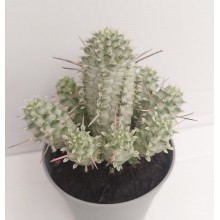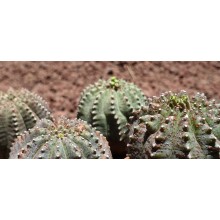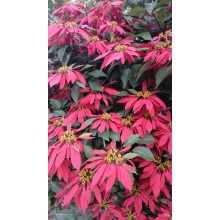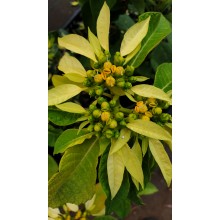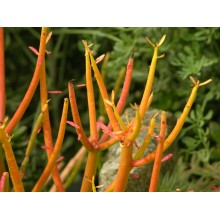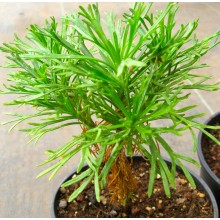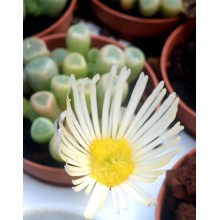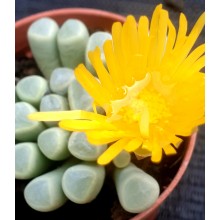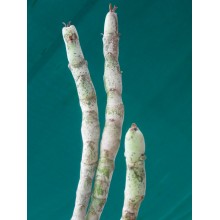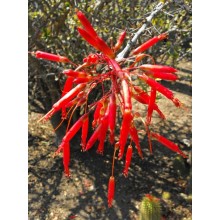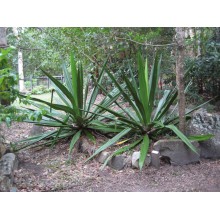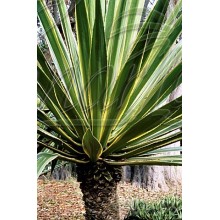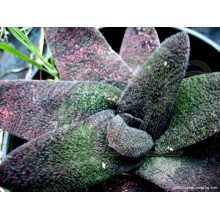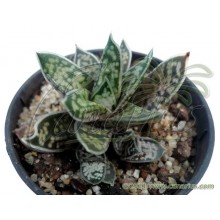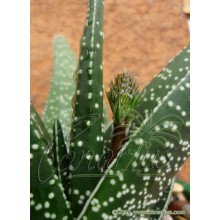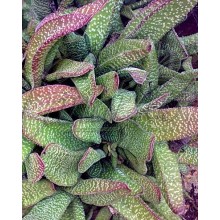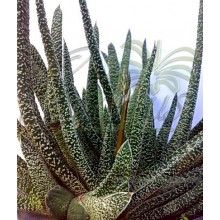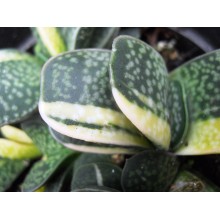Succulents There are 628 products.

World deserts and dry areas are home to the most interesting plants. Canarius offers an increasing selection of succulent plants of maximum quality, because they are grown outdoors, under the full sun of the Canary Islands.
Succulents or "fat plants" are water-retaining species, adapted to dry conditions. They store succum (juice, water) in their leaves, stems or roots, and often show a stout and fleshy appearance.
Subcategories
-
Agave
Agave is a genus of succulent plants from America. Some species grow in cold areas and take hard frost, while some others live in tropical climates. Some are tiny dwarfs and some are giants, up to 2 or 3 m wide.
Cold hardy agaves can create an exotic effect in your garden. Agave species make fine companions to palms or cacti. Variegated agaves are incredibly sought after by collectors. Our web shop offers an ever changing selection of species. We ship bare rooted plants, unless otherwise specified.
-
Aloe, Gasteria & Haworthia
Aloe, Gasteria and Haworthia are three related genera, comprising hundreds of succulent plants. They are all easily grown in pots. A few adapt to low-light levels of indoor conditions and can be grown as house plants.
- Aloe is a genus of about 400 species, native to Africa, Arabia and Madagascar. Small or dwarf aloes are becoming especially popular in colder climates as they can be taken indoors during the hardest months.
- Gasteria includes some 80 species endemic to South Africa, known for their spectacular leaves which are glossy, mottled and textured. They bloom in Spring-Summer with long spikes of small orange flowers. Some species are so variable that we offer particular clones from specific locations.
- Haworthia is a genus endemic to South Africa with about 70 species and a number of local subspecies, varieties and forms. Leaves are often banded, speckled, dotted, or semi-translucent and show wide variations.
-
Crassulaceae
This is a new, growing section of species from the family Crassulaceae. There are about 1,400 species in 33 genera and their distribution is worldwide, but mostly occur in the Northern Hemisphere and Southern Africa, especially in dry habitats. Here you can buy healthy, sun-hardened plants grown in the Canary Islands and shipped to your home.
-
Mesembs
This group of desert plants is briefly named Mesembs because they belong to a botanical family formerly named Mesembryanthemaceae. There are almost 2.000 species, mainly found in Southern Africa, with extreme adaptations to dry habitats. Some are called "living stones", as they look like pebbles. Many are easy to grow and their main need is full sun. Some are difficult because they grow in truly extreme areas.
Our Web Shop offers sun grown healthy plants, with compact and colourful leaves. Some plants are sold as cuttings, and others as rooted plants, of at least two years old.
-
Sansevieria
Recently assigned to the family Asparagaceae, the genus Sansevieria counts about 70 species, nearly all native to Africa, Arabia and Madagascar. Perennial herbs adapted to dry habitats with stiff, succulent leaves, their length ranges from a few centimeters to 2 meters. Sansevieria trifasciata and its many cultivars are among the most popular houseplants, popularly called mother in law's tongue. A well grown plant usually produces a spike of many white, richly scented flowers and then orange berries. Even the rarest species are resistant to neglect, provided you keep them from frost in winter and scorching sun in summer.
-
Hoya
Hoyas are twining vines, with showy exotic flowers, from the rainforests in Asia and Oceania. Most species grow in bright shade or morning sun, but they will also grow indoors as house plants. They are well suited for baskets, trellises or ladders. They tolerate a few weeks of drought but they are sensitive to frost and cold. Many hoyas are easy to grow and bloom, while some are tricky and rare.
-
Asclepiads
Asclepiads or Asclepiadoideae are a subfamily in the Apocynaceae, with about 2900 species. There are lots of leafless stem succulents but also perennial herbs, shrubs, lianas or rarely trees. They produce remarkable flowers, for the complex mechanisms they have developed for pollination. Many species produce an unusual fragrance, often called "carrion", and attracts flies for pollination. -
Caudiciforms
These plants from dry areas produce an unusually thick stem, the caudex. They are also called pachycauls and they have a disproportionately thick trunk, often with few branches. The caudex can be hidden underground, but in most cases they grow upwards, forming spectacular trees. The largest caudiciforms in the world are the baobabs. -
Other succulents
Here you will find all those species of desert plants that are not included in their own category. We will place here all plants from unusual families, other than Agaves, Aloes, Crassulaceae, Sansevieria, Mesembs, Epiphytic cacti, etc.
-
Euphorbia obesa
Euphorbia obesa
This is an old classic for succulent collectors, but still everybody needs a new one. The obese euphorbia is native to the Cape Province of South Africa. It is very elegant and very resistant to neglect. They live for many years at a very slow pace.
11,20 € -
Euphorbia pulcherrima 'Tall Wild Type'
Euphorbia pulcherrima 'Tall Wild Type'
This is the most classic tall heirloom poinsettia which is so widespread in the old gardens of the Canary Islands and the Southern Mediterranean.
24,50 € -
Euphorbia pulcherrima 'Tall Wild Type' YELLOW
Euphorbia pulcherrima 'Tall Wild Type' YELLOW
This is the most classic tall heirloom poinsettia which is so widespread in the old gardens of the Canary Islands and the Southern Mediterranean.
24,50 € -
Euphorbia tirucalli 'Sticks on fire'
Euphorbia tirucalli 'Sticks on fire'
Elegant ornamental super-spiny palm with arching leaves that are glossy and dark-green above and silvery below.
45,00 € -
Euryops socotranus
Euryops socotranus
Rarely cultivated shrub endemic to the island of Socotra. It grows in rocky harsh areas and it is especially abundant at about 1000 m elevation. It is closely related to Euryops arabicus and thrives in coastal Mediterranean conditions. It is suited to pot culture and also makes a nice garden subject for dry sunny areas.
27,50 € -
Fenestraria rhopalophylla - White
Fenestraria rhopalophylla - White
Miniature beauty from South Africa. This succulent has unusual leaves with a translucent window on the top. Beautiful, white, daisy-like flowers. Easy to grow in sand, better with a winter rest.
10,30 € -
Fenestraria rhopalophylla ssp aurantiaca
Fenestraria rhopalophylla ssp aurantiaca
Cont. 6 cm. A beauty from South Africa. This succulent has unusual leaves with a translucent window on the top. Beautiful daisy like flowers. Easy to grow, needs a winter rest.
10,50 € -
Folotsia floribunda
Folotsia floribunda
2 year old seedling, H:20 cm. This Folotsia or Cynanchum looks quite different from those that are around. The thick stems are surely attractive because of their beautiful mottling.
23,00 € -
Fouquieria macdougalii
Fouquieria macdougalii
Succulent shrub from Sonora in Mexico, with arching branches and showy orange-red blooming. It grows well in cultivation and when co nstrained in a pot, it forms a nice short shrub with a caudex and will also bloom.
38,40 € -
Furcraea gigantea
Furcraea gigantea
Beautiful glossy green spineless Furcraea, native to Northern South America. The beautiful large rosettes attain 2 m in mediterranean conditions and almost 4 m in tropical climates. As most other furcraeas, it will stay small and stable forever if kept in pots.
16,50 € -
Furcraea selloa marginata
Furcraea selloa marginata
Stiff, glossy leaves, with golden margins. It is a variegated selection, traditionally planted in gardens of the Canary Islands. This elegant plant usually grows an aerial trunk of 0,5-2 m and then produces an incredibly tall inflorescence.
18,70 € -
Gasteria armstrongii
Gasteria armstrongii
This is the smallest and most compact Gasteria, a true miniature. It is easy to grow but surely slow. We offer one well-rooted head
17,30 € -
Gasteria batesiana Pongola Poort
Gasteria batesiana Pongola Poort
Spectacular form with unreal colours. Leaves are mottled, dark green-pink-grey, covered by shiny bumps. Colour changes through seasons, according to light exposure.
16,00 € -
Gasteria bicolor var. liliputana
Gasteria bicolor var. liliputana
Cont.= 6 cm. One of the smallest gasterias. Clumping rosettes of 4-10 cm. Beautifully spotted leaves turn partially orange in full sun. It is a rare endemic from the Grahamstown quartzitic mountain range. Easy and suitable for indoor growing.
10,70 € -
Gasteria carinata
Gasteria carinata
Cont.= 6 cm. Medium sized species. Leaves are spotted in dark transverse bands. Margins are leathery, with small rounded teeth. It is native to the dry fynbos vegetation of the inland Western Cape. Thrives in Mediterranean climates.
10,70 € -
Gasteria carinata var. carinata
Gasteria carinata var. carinata
NEW ! - Rooted plant, h=8-10 cm. Leaves have a distinct keel and are densely dotted with small white tubercles. This Gasteria is a hardy plant for Mediterranean climates and can stand short freezes.
10,40 € -
Gasteria carinata var. verrucosa
Gasteria carinata var. verrucosa
NEW ! - Rooted plant, h=10-12 cm. Variable subspecies. Leaves have abundant pearl-white tubercles. It is possibly the cold hardiest species in the genus Gasteria as it can withstand temperatures down to -7º C
10,90 € -
Gasteria cv. Variegata
Gasteria cv. Variegata
We offer a clump of three-to-four heads of a nice, easy growing small and distichous gasteria
10,80 €
At the moment there are few products in this category Succulents

























